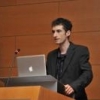http://the-scientist...-advance-aging/Old Cells Advance Aging
By selectively killing senescent cells, researchers can slow the
decline of health in aging mice.
By Tia Ghose | November 2, 2011
Researchers have been able to delay the onset of age-related health
declines in mice by selectively killing off aging cells, suggesting
that cellular senescence can actively causing damage to surrounding
tissue. The findings, published today (November 2) in Nature, could
one day be used to create anti-aging therapies.
“It’s been speculated for some time that these senescent cells are a
major cause of what goes wrong with aging,” said molecular and cell
biologist Judith Campisi of the Buck Institute for Research on Aging
in Calif., who was not involved in the study. “So this is really a
very important step forward in validating that hypothesis.”
Indeed, researchers have long recognized the role of senescent cells—
aging cells which no longer divide—in the health decline that
accompanies aging, such as muscle weakness, heart problems, cataracts,
and other ailments. But it wasn’t clear whether aging cells cause harm
because they actively secrete inflammatory molecules such as
cytokines, or whether they were simply dead weight, harmful because
they had lost their normal cellular functions, said Norman Sharpless,
a gerontologist and oncologist at the University of North Carolina at
Chapel Hill, who was not involved in the study.
To answer this question, cancer biologist Jan van Deursen of the Mayo
Clinic and his colleagues developed a clever test. Senescent cells,
which often harbor genetic damage, secrete a tumor suppressor molecule
called p16. Van Deursen and his team created mice that age
prematurely, falling prey to a variety of age-related diseases early
in life. They also inserted a gene into the mouse genome, which
allowed them to selectively kill cells expressing p16 by feeding the
mice rosiglitazone, a common diabetes drug.
Mice fed a diet containing rosiglitazone from infancy took much longer
to develop muscle weakness, cataracts, and other signs of aging than
controls. Even when older mice were fed rosiglitazone, many of the age-
related problems plateaued. The findings suggest that senescent cells
actively cause harm, and that killing them can delay at least some
forms of aging. “If you translate that to humans, if you were to clear
senescent cells regularly from a young age, that would probably have a
major impact on health span,” van Deursen said.
Selectively killing off p16 didn’t slow all forms of aging, however.
The treatment had no effect on the unusually high rates of heart
disease seen in the mice. As a result, most mice still died of heart
problems and the overall lifespan of the mice didn’t increase. In
addition, the study looked at rapidly aging mice, but the researchers
need to confirm that the same benefits occur in naturally aging mice,
Campisi said.
Still, the study suggests a potential pathway for delaying aging in
humans, Sharpless said. If cytokines and other inflammatory signals
are the root of senescent cells’ adverse effects, “it’s not difficult
to make drugs that interfere with [such signaling].” The trick would
be determining which signals to target and ensuring that they don’t
have undesirable side-effects, such as lessening people’s immune
response to infection, he said.
D. J. Baker et. al, “Clearance of p16-Ink4a-positive senescent cells
delays ageing-associated disorders,” Nature, doi:10.1038/nature10600,
2011.



























































